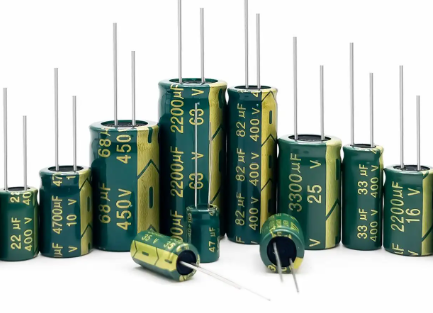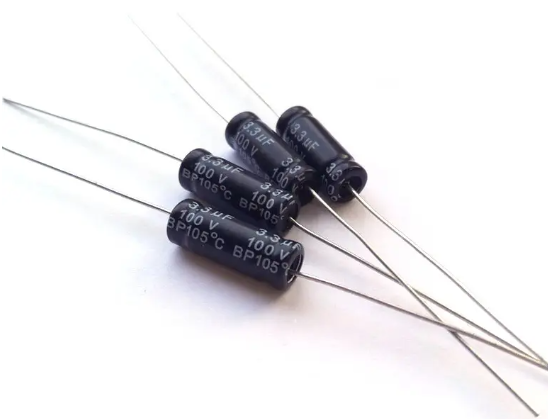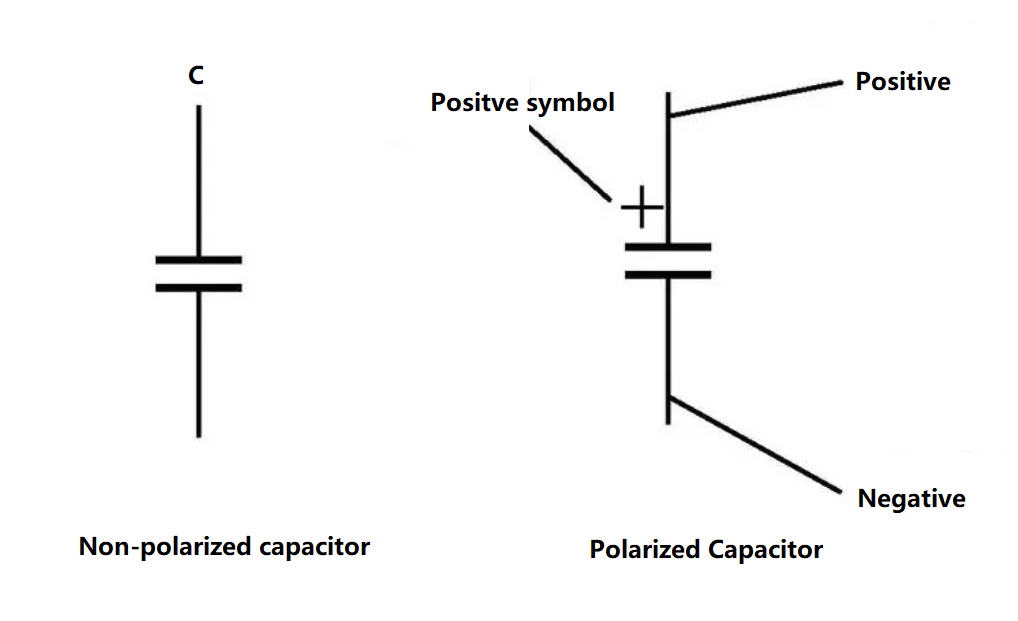Polarized vs Non-Polarized Capacitor: Introduce and Capacitor Symbol

As we all know, our life and work are commonly used capacitors. An ideal capacitor would have no polarity. However, in practice, in order to obtain large capacity, some special materials and structures are used, which results in some actual capacitors being polar. Common polar capacitors are aluminum electrolytic capacitors, tantalum electrolytic capacitors and so on. Electrolytic capacitors are generally relatively large in capacity. If you want to make a large-capacity non-polar capacitor, it is not so easy, and the volume will become very large. That's why there are so many polar capacitors in actual circuits.
What is a Polarized Capacitor?
A polarized capacitor is a type of capacitor that has a specific polarity, meaning it has positive and negative leads. These capacitors must be connected correctly in a circuit, with the positive lead connected to the higher voltage side. Polarized capacitors, such as electrolytic and tantalum capacitors, are commonly used in DC circuits where large capacitance values are required.
Their main feature is that they have positive and negative polarity, and the requirements of positive and negative polarity need to be followed when used, otherwise the capacitor may be damaged. The construction of a polar capacitor consists of two layers of metal foil as a positive and negative plate, separated by a dielectric (usually an electrolyte), while the negative plate is coated with electrolyte. The polarity of this capacitor is very important for its capacity, and the wrong connection of positive and negative polarity may lead to serious consequences such as short circuit of the capacitor, explosion, etc. Polar capacitors are usually used in large-capacity electronic equipment, such as power filter capacitor, power amplifier capacitor, DC isolation capacitor, etc., because of their high capacitance and voltage.

Types of Polarized Capacitors
Polarized capacitor is divided into electrolytic capacitor and polymer capacitor. They are featured in different characteristics.
1. Aluminum electrolytic capacitors
These are the most common type of polarized capacitors, characterized by their high capacitance values relative to their size. They are made by placing a thin oxide layer on an aluminum foil, which acts as the dielectric, and then rolling it up with another foil and a paper soaked in electrolyte.
2. Tantalum electrolytic capacitors
These capacitors use tantalum for the electrodes, providing better performance in terms of stability, leakage current, and equivalent series resistance (ESR) compared to aluminum electrolytics. They are typically found in applications requiring high reliability.
3. Polymer capacitors
These are a variation of electrolytic capacitors where the electrolyte is replaced with a conductive polymer, offering lower ESR and longer life spans. They are used in high-performance applications such as computer motherboards and power supplies.
What is a Non-Polarized Capacitor?
A non-polarized capacitor, also known as a biphasic capacitor, can be connected in any direction within a circuit, as it does not have positive or negative leads. These capacitors are versatile and can handle both AC and DC voltages. The construction of non-polarized capacitors involves dielectric materials such as ceramic, plastic film, mica, or glass sandwiched between two conductive plates. They are preferred in applications where the direction of the voltage can change, such as in AC circuits.

Types of Non-Polarized Capacitors
1. Ceramic Capacitors
l Multilayer ceramic capacitors (MLCCs)
These are widely used for their small size, high capacitance, and stability. They are made by stacking multiple layers of ceramic dielectric and metal electrodes.
l Disc ceramic capacitors
These are simpler in construction and used in applications where high frequency stability is needed.
2. Film Capacitors
l Polyester film capacitors
Known for their reliability and stability, they are used in applications such as motor run capacitors and power supplies.
l Polypropylene film capacitors
These offer excellent electrical properties and are used in high-frequency applications.
3. Mica Capacitors
Made using thin sheets of mica as the dielectric, they provide high stability and low loss, ideal for RF applications.
4. Glass Capacitors
These are highly stable and reliable, used in demanding applications like aerospace and military electronics.
How Do Non-Polarized Capacitors Work?
Non-polarized capacitors store and release electrical energy without regard to the direction of the applied voltage. They work by accumulating charge on their plates when voltage is applied. When the voltage source is removed, the stored energy can be released back into the circuit. They are constructed using dielectric materials such as ceramic, film. These materials are sandwiched between two conductive plates. Unlike polarized capacitors, non-polarized capacitors do not have an electrolytic solution, which is why they can be connected in any orientation.
The working principle of non-polarized capacitors is the same as that of all capacitors. They store electrical energy in an electric field created between two conductive plates separated by a dielectric material. Here's a comprehensive explanation of how they work.
1. Charging phase
When a voltage is applied across the capacitor's terminals, an electric field is established between the plates. Electrons accumulate on one plate, creating a negative charge, while the other plate loses electrons, creating a positive charge. And the dielectric material between the plates prevents direct current (DC) from flowing through, allowing the capacitor to store energy.
2. Energy storage
The energy stored in the capacitor is proportional to the voltage applied and the capacitance of the device. The relationship is given by the formula: E=1/2CV2, where E is the stored energy, C is the capacitance, and V is the voltage.
3. Discharging phase
When the external voltage source is removed, the stored energy can be released back into the circuit. The capacitor discharges by allowing the accumulated charge to flow through the circuit until the voltage across the plates equalizes.
4. AC operation
In AC circuits, the voltage polarity alternates, causing the capacitor to continuously charge and discharge with each cycle. Non-polarized capacitors handle this alternating voltage without any risk of damage, making them ideal for applications like signal coupling and filtering.
Capacitor Symbol
Capacitors have distinct symbols used in circuit diagrams. The symbol for a polarized capacitor typically includes a plus sign (+) to denote the positive lead. Non-polarized capacitors are represented by two parallel lines of equal length. These symbols help in identifying the type of capacitor and ensuring correct circuit design. You can see their capacitor symbols as following:

Why Do We Use Non-Polarized Capacitors?
Non-polarized capacitors are favored in various electronic applications due to their inherent flexibility and broad functionality. Their ability to function without regard to voltage polarity allows them to be used in numerous AC and DC circuits. Here are several key reasons why non-polarized capacitors are widely used:
Flexibility in circuit design
Non-polarized capacitors can be installed in any direction, offering significant flexibility in circuit design. So that it reduces complexity and the risk of errors associated with the orientation of components, streamlining the design process.
Compatibility with AC and DC circuits
These capacitors can operate effectively in both AC and DC environments. Their ability to withstand voltage reversals without damage makes them ideal for applications where the voltage direction varies, such as in signal processing and power conditioning.
Consistent performance
Non-polarized capacitors exhibit stable performance across a range of temperatures and frequencies. This is crucial for critical applications like radio frequency (RF) circuits, oscillators, and timing devices.
Ease of use
Compared with polarized capacitor, they are relatively easy to use. Designers and technicians can install these components without worrying about orientation, reducing the likelihood of installation errors and component damage.
Variety of types and materials
Non-polarized capacitors come in various types and materials. So, it can provide numerous choices for designers to choose the most suitable capacitor based on the specific needs of their application, including capacitance, voltage rating, and physical size.
What is the Difference Between Polarized and Non-Polarized Capacitors?
The differences between polarized and non-polarized capacitors are highlighted in the following table, hope this is helpful for you.
|
Item |
Polarized Capacitors |
Non-Polarized Capacitors |
|
Polarity |
Has distinct positive and negative leads; must be connected correctly. |
No polarity; can be connected in any direction. |
|
Types |
Electrolytic, Tantalum, Polymer |
Ceramic, Film, Mica, Glass |
|
Capacitance Range |
High capacitance values |
Generally lower capacitance values compared to polarized capacitors. |
|
Size |
Compact for high capacitance |
Can be larger for high capacitance values. |
|
Voltage Handling |
Used in low to moderate voltage applications. |
Suitable for a wide range of voltage applications, including high-frequency AC. |
|
Installation |
Must observe correct polarity to prevent damage. |
No concerns about polarity; easier installation. |
|
Reliability |
Sensitive to incorrect polarity, which can cause failure. |
No concerns about polarity; easier installation. |
|
Frequency Stability |
Generally less stable at high frequencies. |
Excellent stability at high frequencies. |
Can I Replace a Non-Polarized Capacitor with a Polarized Capacitor?
In most cases, you cannot replace a non-polarized capacitor with a polarized one. The directionality of the voltage in circuits using non-polarized capacitors makes polarized capacitors unsuitable. However, in specific DC applications where voltage direction is constant, it might be possible, but it’s crucial to ensure the voltage does not reverse. Here are some considerations you must to noticed.
Non-polarized capacitors are designed to handle voltage in both directions, making them suitable for AC circuits and DC circuits where the voltage polarity can change. In contrast, polarized capacitors have distinct positive and negative leads and must be connected with the correct polarity to avoid damage. In DC circuits where the voltage direction is constant, it may be possible to replace a non-polarized capacitor with a polarized one, provided the voltage does not reverse and the capacitance and voltage ratings match the circuit's requirements.
However, this substitution requires careful attention to the capacitor's polarity markings to ensure correct installation. Using a polarized capacitor in AC circuits is not recommended, as the alternating voltage can cause the capacitor to fail or even explode. Additionally, polarized capacitors may exhibit different performance characteristics, such as higher leakage currents and varying frequency responses, which can affect the circuit's overall performance. Therefore, while possible in specific cases, replacing non-polarized capacitors with polarized ones should be approached with caution, ensuring all circuit requirements and conditions are thoroughly understood to avoid potential risks and performance issues.
When to Use a Polarized Capacitor?
Polarized capacitors are widely used in electronics because its high capacitance values. Below are some common applications:
l High capacitance requirements
l DC circuits
l Smoothing and filtering
l Energy storage
l Audio coupling and decoupling
l Timing circuits
l Low frequency applications
How to Select Non-polarized Capacitors?
When choosing a non-polarized capacitor, several factors need to be considered to ensure they meet the requirements of your circuit or application. Here's a comprehensive guide to help you select the right non-polarized capacitors:
1. Capacity selection
The capacity selection of non-polarized capacitors is similar to that of ordinary capacitors and is determined according to the circuit requirements. It is necessary to select the appropriate capacitance value according to the frequency and impedance parameters in the circuit. For high-frequency applications, choose capacitors with suitable capacitance values to achieve the desired filtering or coupling effects. In the oscillating circuit, filter circuit, delay circuit and tone circuit, the absolute value of error needs to be within 0.3% to 0.5%.
2. Voltage level
The voltage level of the non-polarized capacitor is also a crucial factor to consider. Choose a capacitor with a voltage rating higher than the maximum voltage the circuit will experience. It's recommended to select a capacitor with a voltage rating at least 1.5 to 2 times the circuit's operating voltage to prevent overvoltage conditions. Additionally, consider potential voltage spikes or transients that could exceed the normal operating voltage and choose a capacitor that can handle these conditions without degradation.
3. Size and package
Select the appropriate size and package of the capacitor according to the specific circuit requirements. Non-polarized capacitors are available in various packaging forms, such as surface mount (SMT) and through-hole (pin type). Choose the right package type based on your circuit board layout and assembly process. For compact and portable electronic devices, select capacitors with smaller sizes and suitable mounting options to save space and ensure efficient assembly.
4. Temperature characteristics
The temperature characteristics of non-polarized capacitors are also important factors that need attention. In some special working environments, where temperature fluctuations are significant, it is necessary to choose non-polarized capacitors with good temperature stability. Ensure the capacitors maintain their performance without significant changes in capacitance or leakage current over a wide temperature range. For high-temperature environments, select capacitors with high-temperature ratings and stable performance, while for low-temperature environments, ensure they perform reliably without degradation.
5. Dielectric materials
Different dielectric materials offer varying performance characteristics. Common dielectric materials include ceramic, polyester, polypropylene, and mylar. Ceramic capacitors are known for their low inductance and ESR, making them suitable for high-frequency applications. Polyester and polypropylene capacitors offer good stability and are often used in audio and RF circuits. Mylar capacitors are known for their reliability and stable capacitance over a wide temperature range. Select the dielectric material based on factors such as stability, temperature range, and application requirements.
6. Reliability and lifetime
Choose capacitors from reputable manufacturers known for producing reliable components. Check datasheets for information on the expected lifetime of the capacitor under specific conditions. If possible, test the selected capacitor in your circuit before full-scale implementation to ensure it meets your performance expectations. Reliability and longevity are critical, especially in applications where capacitor failure could lead to significant issues.
FAQs
How can you identify if a capacitor is polarized or non-polar?
Polarized capacitors typically have a clear marking on one of their leads to indicate polarity. This can be a plus (+) sign for the positive lead or a minus (-) sign for the negative lead. Non-polarized capacitors, on the other hand, do not have such markings and can be connected in any direction in the circuit.
What capacitor is always polarized?
Electrolytic capacitors are always polarized. They have distinct positive and negative leads and must be connected correctly to function properly and avoid damage.
Are all ceramic capacitors
non-polarized?
Yes, all ceramic capacitors are non-polarized. This means they can be connected in any direction in the circuit without concern for polarity.
What are the advantages of non-polarized capacitors?
Non-polarized capacitors can be connected in any direction, which simplifies circuit design and reduces the risk of incorrect installation. They are ideal for AC applications, such as signal coupling and filtering, where polarity is not a concern. Additionally, non-polarized capacitors often exhibit better high-frequency performance and lower leakage currents compared to their polarized counterparts.
Statement
All articles (images, texts, audio) on this site are uploaded and shared by users, or integrated from relevant internet sources, only for user's learning. If your rights are violated, please contact the administrator to delete! Link to this article: https://www.jinftry.com







